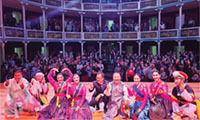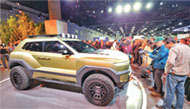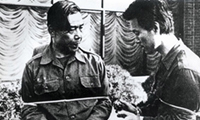A Blacksmith’s Touch Makes the Music Light
Weighing tons, his spindly abstractions of steel and bronze - “The Long I,” “Cut Out,” “0 + 1” - inscribe the landscape like quick strokes and squiggles of some titan’s pen. Rising as high as 30 meters they catch movement in the air and give forth the gentlest of music. “What I want is to make heavy things light,” Mr. Fuchs said . “That in turn makes my life difficult.”
Apart from the principal dwelling, a stable for the horses and a workshop that sometimes doubles as a gallery, his compound has a barn packed with an astonishment of instruments: a thunder sheet ; a suspended assemblage of hollowed-out wooden block s; assorted bells, whisks and sticks. There are motorized sound generators too, one outfitted with heavy-duty rubber boots.
Trained as a blacksmith, then as an artist, Mr. Fuchs has evolved into a musician without any formal training.
“The rhythm of the hammer on iron, the sheer physical work, was always music to me,” he said.
He plays every few days for his own enjoyment. Private tours of the grounds, conducted for groups of eight or more (by reservation only, at paul.fuchs@ tiscalinet.it), feature performances too.
“As a little boy,” Mr. Fuchs said, “I wanted to learn the violin, but my hands weren’t built for that. Working with metal, I could never mold them to conventional instruments. I made trumpets for other musicians and also horns of copper, wood and bronze that I could blow myself: simple sculptural tubes and cones that made amazing sounds. I still play them.”
He added: “I never copied things that already existed. The instruments were never Indian or Turkish or European. I never cared about playing the overture of some opera. I wanted my breath to open out into sound.”
Originally developed at the request of a music therapist, the spooky ballastsaiten (weighted strings) quickly became an integral part of the Fuchs paraphernalia. It consists of strings, attached weights and a drum head that resonates when the strings are brushed or plucked. Mr. Fuchs has also developed a sort of caveman’s xylophone of carefully selected granite plates.
Mr. Fuchs has collaborated with classical musicians as well as with more folkloric performers, like the American Indian flutist R. Carlos Nakai. “Paul intrigued me,” Mr. Nakai said. “I listened to the sounds he made and thought: ‘This is really special. ‘ ” Mr. Fuchs invited him on a tour of West Germany in 1988.
Pamela Hyde-Nakai, Mr. Nakai’s wife, remembers their tour.
“We traveled with a flatbed truck, with all this stuff on the back, and every time we had to perform, Paul had to lug it all off,” she said. “It was big and heavy. It was the most cumbersome way to put on a show I’d ever seen. It was quite the adventure . ”
For Mr. Fuchs, a collaborator’s musical pedigree is on one level completely unimportant.
“The only people who can be partners for me are people who think beyond music,” he said. “These days I work a lot with Hariolf Schlichtig, the violist of the Cherubini String Quartet and a professor at the Hochschule fur Musik und Theater in Munich. ”
When recently asked by a concert pianist if he considered himself a musician, Mr. Fuchs said he replied: “Not the way you are. I don’t have 24 keys in my pocket and all the harmonies that go with them. But I make music, and you make music too.” He added: “Am I a musician or a sound artist? Really, I don’t care.”
By MATTHEW GUREWITSCH
스마터리빙
more [ 건강]
[ 건강]이제 혈관 건강도 챙기자!
[현대해운]우리 눈에 보이지 않기 때문에 혈관 건강을 챙기는 것은 결코 쉽지 않은데요. 여러분은 혈관 건강을 유지하기 위해 어떤 노력을 하시나요?
 [ 건강]
[ 건강]내 몸이 건강해지는 과일궁합
 [ 라이프]
[ 라이프]벌레야 물럿거라! 천연 해충제 만들기
 [ 건강]
[ 건강]혈압 낮추는데 좋은 식품
[현대해운]혈관 건강은 주로 노화가 진행되면서 지켜야 할 문제라고 인식되어 왔습니다. 최근 생활 패턴과 식생활의 변화로 혈관의 노화 진행이 빨라지고
사람·사람들
more
모교에 200만불 기부
로스알토스에 거주하는 재미 한인 사업가 노의용(제임스 노)씨와 부인 이선은씨가 삼육대학교(총장 제해종)에 200만 달러를 기부했다. 노의용씨와…

한국음악무용예술단, 에콰도르 로하 축제서 공연
김동석 교수가 이끄는 한국음악무용예술단이 지난 17일부터 22일까지 에콰도르 로하에서 열린 제10회 로하 국제예술축제에 첫 한국 대표로 참가해…
성남고 동문회 송년의 밤 행사
남가주 성남고 동문회의 송년의 밤 행사가 지난 22일 LA 옥스포드 팔레스호텔 1층 갤러리아 홀에서 성황리에 열렸다. 이날 행사에는 50여명이…
서울사대부고 동창회 이사회
서울사대부고 남가주 동창회(회장 김흥숙)가 지난 22일 세리토스에 위치한 서울대 동문회관에서 이사회를 개최했다. 이날 이사회에는 신·구 임원진…
외대 동문회 장학생 모집 동문 자녀 대상 지원접수
한국외국어대학교 남가주 동문회 장학위원회가 동문 자녀들을 대상으로 2025년도 장학생을 모집한다.동문회 측은 젊은 세대 동문들과의 유대관계 형…
많이 본 기사
- “오바마케어 보조금 확대조치 2년 연장”
- “올해 최악 독감시즌 될 것” 경고
- 세계 최대 생나무 크리스마스트리… LA 시타델서 불 밝혀
- “선생님과 인연 없는 배우 있겠나”…이틀째 故이순재 조문 행렬
- 복수국적 2세 피해 방지… ‘국적유보 신고제’ 추진
- 연말 샤핑시즌 ‘현관 해적’ 경계령
- 한인 연방판사 “유력 대법관 후보”
- 베조스 부부 뉴욕 메트갈라 스폰서 선정 논란
- 국립공원 입장료도 ‘미국 우선주의’
- “테슬라 급발진 화재에 문 안 열려 희생됐다”
- 연휴 LA공항 이용객 250만명 사상 최다
- 바이든 고령 조롱했던 79세 트럼프도 ‘나이는 못 속여’
- 정혜선한국전통예술원 ‘아리랑-동방의 울림’공연 성황
- 오바마케어 보조금 2년 더 연장되나
- 킹달러 ‘코리아 디스카운트’… 미주한인 방문 급증
- 모교에 200만불 기부
- “007(24시간·7일) 근무 중 시장 다 내줄 판” 업계 호소에도 예외 불발
- 특검, 한덕수 징역 15년 구형… “… 1
- ‘그때 그사람’ 가수 심수봉, ‘10·26’ 김재규 재심 증인 불출석
- ‘이스라엘과 수교’ 요청 거부한 빈 … 2
- “모든 일은 이유가 있다” 클라라, 이혼 후 또 의미심장 글
- 法 “장우혁 폭행 가능성 더 높아”..전 소속사 직원, 명예훼손 1심 무죄
- 살인·폭력 악명높은 퀸즈 갱단 일망타진
- ‘미국에 물 빚’ 멕시코, 수자원법 개정 진통
- 남가주 한인미술가협 신입회원전
- 애플까지 인력 줄여… 무게 실리는 금리 인하
- “태권도가 닌자 훈련?”… 스포츠채널 ‘황당 표기’
- ‘조금만 도와주는 일’의 아름다움
- 한인 2세‘발목’선천적 복수국적법 개정 빛 보인다
- 트럼프 “우크라 종전 합의 매우 가까워…1주일간 엄청난 진전”
- “일 커질 줄 몰라”..리센느, 학대 의혹 2차 해명 속 걱정 없이 컴백
- “AI가 먹어도 된다고 했는데”…야생… 1
- 가주 재정적자 악화… 내년 180억불 달할듯
- 묵직한 카레는 가라… 점심마다 줄 서는 ‘향신료 카레’
- 러 “우크라 계획 수정안서 ‘핵심’ 제거됐다면 상황 달라질 것”
- 10대 죽음에 책임공방… “챗GPT가 유도” vs “기존부터 자해위험”
- 李대통령, 순방 마치고 귀국…국내현안 살피며 ‘성과 창출’ 주력
- 버지니아 종합기술학교 종강식…냉난방반 수강생 전원 면허 취득
- 트럼프 “위트코프, 내주 푸틴 만날것…우크라 안보보장에 유럽 관여”
- 미국, 실패한 우크라이나 정책으로 회귀
- [송년행사 게시판] 대한항공 여승무원동우회 外
- 9월 생산자물가 전월대비 0.3%↑…예상 부합
- ‘우승 유력’ 손흥민 탈락, 美 현지… 1
- 애난데일서 활동 20대 마약 딜러 ‘징역 15년형’
- 파바월드, 시니어센터서 추수감사절 큰잔치
- FIFA 랭킹 1~4위 월드컵 4강 가야 대결…한국 포트2 확정
- 이이경 ‘놀뭐’ 저격, 유재석에 불똥..프로그램 하차 소신 ‘재조명’
- 양정동문회 내달 13일 뉴욕·뉴저지 송년의 밤
- 대학서 강의하는 이란 국적 정치학자, ICE에 사흘간 구금
- “파월 후임에 트럼프 참모 해싯 유력”…미 국채 금리 하락
1/5지식톡

-
 테슬라 자동차 시트커버 장착
0
테슬라 자동차 시트커버 장착
0테슬라 시트커버, 사놓고 아직 못 씌우셨죠?장착이 생각보다 쉽지 않습니다.20년 경력 전문가에게 맡기세요 — 깔끔하고 딱 맞게 장착해드립니다!장착비용:앞좌석: $40뒷좌석: $60앞·뒷좌석 …
-
 식당용 부탄가스
0
식당용 부탄가스
0식당용 부탄가스 홀세일 합니다 로스앤젤레스 다운타운 픽업 가능 안녕 하세요?강아지 & 고양이 모든 애완동물 / 반려동물 식품 & 모든 애완동물/반려동물 관련 제품들 전문적으로 홀세일/취급하는 회사 입니다 100% …
-
 ACSL 국제 컴퓨터 과학 대회, …
0
ACSL 국제 컴퓨터 과학 대회, …
0웹사이트 : www.eduspot.co.kr 카카오톡 상담하기 : https://pf.kakao.com/_BEQWxb블로그 : https://blog.naver.com/eduspotmain안녕하세요, 에듀스팟입니다…
-
 바디프렌드 안마의자 창고 리퍼브 세…
0
바디프렌드 안마의자 창고 리퍼브 세…
0거의 새제품급 리퍼브 안마의자 대방출 한다고 합니다!8월 23일(토)…24일(일) 단 이틀!특가 판매가Famille: $500 ~ $1,000Falcon: $1,500 ~ $2,500픽업 & 배송직접 픽업 가능LA…
-
 바디프렌드 안마의자 창고 리퍼브 세…
0
바디프렌드 안마의자 창고 리퍼브 세…
0거의 새제품급 리퍼브 안마의자 대방출 한다고 합니다!8월 23일(토)…24일(일) 단 이틀!특가 판매가Famille: $500 ~ $1,000Falcon: $1,500 ~ $2,500픽업 & 배송직접 픽업 가능LA…
케이타운 1번가
오피니언
 정숙희 논설위원
정숙희 논설위원‘조금만 도와주는 일’의 아름다움
 파리드 자카리아 워싱턴포스트 칼럼니스트 / CNN ‘GPS’ 호스트
파리드 자카리아 워싱턴포스트 칼럼니스트 / CNN ‘GPS’ 호스트 미국, 실패한 우크라이나 정책으로 회귀
 김동찬 시민참여센터 대표
김동찬 시민참여센터 대표 [미국은 지금] 2025년 추수감사절의 그림자
 이현숙 수필문학가협회 이사장
이현숙 수필문학가협회 이사장 [수요 에세이] 미시시피 강의 물결
 서정명 / 서울경제 논설위원
서정명 / 서울경제 논설위원[만화경] ‘김 부장 이야기’와 취업난 실상
 조환동 편집기획국장·경제부장
조환동 편집기획국장·경제부장 연말 샤핑은 한인타운·한인업소에서
 민경훈 논설위원
민경훈 논설위원새나가는 권력과 도널드의 분노
 김도년 성균관대 건축학과 교수 스마트도시·건축학회장
김도년 성균관대 건축학과 교수 스마트도시·건축학회장 [로터리] 하이퍼로컬, 동네 2.0
 정유환 수필가
정유환 수필가 [화요칼럼] 넌 할 수 있어, 말해주세요
1/3지사별 뉴스

정혜선한국전통예술원 ‘아리랑-동방의 울림’공연 성황
정혜선한국전통예술원의 특별공연 ‘아리랑-동방의 울림’(Arirang-Echoes of the East)이 지난 23일 전석 매진속에 뉴저지 포…
오바마케어 보조금 2년 더 연장되나

한인 2세‘발목’선천적 복수국적법 개정 빛 보인다
한인 2세들의 발목을 잡고 있는 선천적 복수국적법 문제 해결을 위한 ‘국적자동상실제’ 도입의 물꼬가 트일 전망이다. 지난 21일 국회의원회관…
“K-음식과 문화 함께 버무렸다”

가주지사 선거 ‘군웅할거’… 주요 후보 20여명 난립
내년 실시될 캘리포니아 주지사 선거가 벌써부터 전례 없는 혼전 양상을 보이고 있다. 전·현직 의원, 정부 고위 관료, 억만장자, 경찰 출신 등…
[알립니다]‘온정의 슬리핑백’ 보내기 운동

오늘 하루 이 창 열지 않음 닫기 


















































.png)


댓글 안에 당신의 성숙함도 담아 주세요.
'오늘의 한마디'는 기사에 대하여 자신의 생각을 말하고 남의 생각을 들으며 서로 다양한 의견을 나누는 공간입니다. 그러나 간혹 불건전한 내용을 올리시는 분들이 계셔서 건전한 인터넷문화 정착을 위해 아래와 같은 운영원칙을 적용합니다.
자체 모니터링을 통해 아래에 해당하는 내용이 포함된 댓글이 발견되면 예고없이 삭제 조치를 하겠습니다.
불건전한 댓글을 올리거나, 이름에 비속어 및 상대방의 불쾌감을 주는 단어를 사용, 유명인 또는 특정 일반인을 사칭하는 경우 이용에 대한 차단 제재를 받을 수 있습니다. 차단될 경우, 일주일간 댓글을 달수 없게 됩니다.
명예훼손, 개인정보 유출, 욕설 등 법률에 위반되는 댓글은 관계 법령에 의거 민형사상 처벌을 받을 수 있으니 이용에 주의를 부탁드립니다.
Close
x